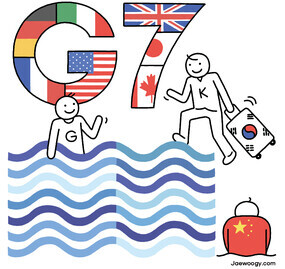hankyoreh
Links to other country sites 다른 나라 사이트 링크
[Column] Why Moon is going to the G7 summit

The first G6 summit took place in 1975, when the leaders of the US, Japan, the UK, France, West Germany and Italy met at the Chateau de Rambouillet near Paris. Coming at a time when the Cold War was still raging, it marked the creation of a framework for the major capitalist countries to discuss big global political and economic issues.
The following year, Canada joined the framework, which became the G7. After the Cold War ended, Russia joined in 1998 to make it the G8, although it ended up reverting to the G7 when Russia was evicted for President Vladimir Putin’s decision in 2014 to forcibly annex the Crimean Peninsula, which was Ukrainian territory.
The European Union (EU) has not been an official member, but it has been present at all discussions since 1977 (when it was known as the European Community).
On June 11-13, the first G7 summit in two years is set to take place at the Carbis Bay Hotel on the southern English coast in Cornwall. Then-US President Donald Trump was originally set to host last year’s summit, but it ended up being cancelled for the first time in history due to the worsening COVID-19 pandemic.
This year’s summit will be the first face-to-face meeting among major heads of state since the pandemic erupted. South Korea has been invited as a guest participant along with Australia, India and South Africa.
South Korean President Moon Jae-in will be attending his first-ever G7 summit. South Korea has been invited for two years in a row, but Moon was unable to attend last year’s event because of the cancellation.
Why was South Korea invited to the G7?
When the first G7 summit was held in 1975, the G7 countries accounted for around 80% of global GDP; today, that has fallen to around 40%. Amid growing talk about the uselessness of the G7 after the Global Financial Crisis began in the US in 2008, a separate G20 group was set up.
Given the G7’s diminished prestige, the Biden administration is pushing to expand the group to become a “D10” association of democratic states that would have more influence and reinforce the US’ campaign to contain China. The three new members would be South Korea, which is now the world’s 10th largest economy; India, which has the world’s second-largest population; and Australia, which has abundant natural resources and a robust IT industry.
The biggest question about this summit is whether Europe will embrace Biden’s offer to repair the NATO relationship wrecked under Trump and present a united front against China.
European countries have recently been growing more critical and concerned about China’s worsening human rights situation, its habit of bullying other countries into transferring technology, and its economy’s reliance on state-owned enterprises. The European Parliament has even suspended ratification of an investment agreement with China.
While Germany and other European states are opposed to measures that would severely damage economic ties with China, the G7 members and observer countries will probably make a show of jointly calling out China on these issues.
Reports indicate that the joint statement produced in the G7 summit is likely to include an expression of concern about tensions in the Taiwan Strait, China’s crackdown on democracy in Hong Kong, and the detention of Uighurs in concentration camps in Xinjiang.
Other items on the agenda are cutting-edge technology, climate change, creating a new world order through reform of the World Trade Organization (WTO), and rich countries doing more to provide COVID-19 vaccines to poor countries.
South Korea’s invitation to the G7 summit gives it more room for diplomacy. But it also means that Seoul needs to play a bigger role and take on more responsibility.
By Park Min-hee, editorial writer
Please direct comments or questions to [english@hani.co.kr]

Editorial・opinion
![[Editorial] Penalties for airing allegations against Korea’s first lady endanger free press [Editorial] Penalties for airing allegations against Korea’s first lady endanger free press](https://flexible.img.hani.co.kr/flexible/normal/500/300/imgdb/original/2024/0502/1817146398095106.jpg) [Editorial] Penalties for airing allegations against Korea’s first lady endanger free press
[Editorial] Penalties for airing allegations against Korea’s first lady endanger free press![[Editorial] Yoon must halt procurement of SM-3 interceptor missiles [Editorial] Yoon must halt procurement of SM-3 interceptor missiles](https://flexible.img.hani.co.kr/flexible/normal/500/300/imgdb/child/2024/0501/17145495551605_1717145495195344.jpg) [Editorial] Yoon must halt procurement of SM-3 interceptor missiles
[Editorial] Yoon must halt procurement of SM-3 interceptor missiles- [Guest essay] Maybe Korea’s rapid population decline is an opportunity, not a crisis
- [Column] Can Yoon steer diplomacy with Russia, China back on track?
- [Column] Season 2 of special prosecutor probe may be coming to Korea soon
- [Column] Park Geun-hye déjà vu in Yoon Suk-yeol
- [Editorial] New weight of N. Korea’s nuclear threats makes dialogue all the more urgent
- [Guest essay] The real reason Korea’s new right wants to dub Rhee a founding father
- [Column] ‘Choson’: Is it time we start referring to N. Korea in its own terms?
- [Editorial] Japan’s rewriting of history with Korea has gone too far
Most viewed articles
- 160% of young Koreans see no need to have kids after marriage
- 2Presidential office warns of veto in response to opposition passing special counsel probe act
- 3Months and months of overdue wages are pushing migrant workers in Korea into debt
- 4[Editorial] Penalties for airing allegations against Korea’s first lady endanger free press
- 5Hybe-Ador dispute shines light on pervasive issues behind K-pop’s tidy facade
- 6Japan says it’s not pressuring Naver to sell Line, but Korean insiders say otherwise
- 7S. Korea “monitoring developments” after report of secret Chinese police station in Seoul
- 8[Column] Unsettling moves by the UN Command lay way for Korean involvement in Taiwan
- 9[Reporter’s notebook] In Min’s world, she’s the artist — and NewJeans is her art
- 10[Column] Park Geun-hye déjà vu in Yoon Suk-yeol